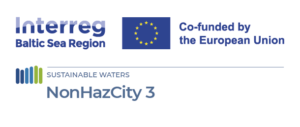Are baby care products free from health hazards?
Despite the fact that baby care products are subject to much stricter regulation, babies are exposed to a mixture of hazardous chemicals through everyday products and the environment.
The problem
Many baby care products may contain ingredients that have an irritating or allergenic effect and are suspected of being carcinogenic (cause cancer) or disrupting the endocrine system. Endocrine disruptors are chemicals that interfere with the endocrine (or hormone) system and could cause tumours, reproductive disorders, birth defects, and other developmental disorders. Regular contact with harmful substances, for instance when using cosmetic products on the skin may lead to their absorption into the body. The more chemicals are taken up, the more likely it is that they could have an effect on our health. Therefore, it is useful to reduce contact to hazardous chemicals in e.g. cosmetic products, if possible.
Although most cosmetic ingredients are listed on the packaging with their technical terms (INCI – Nomenclature), these technical terms are still incomprehensible to many people. This pocket guide aims to explain which substance/ingredients to look for and why.
Children are much more sensitive to exposure to toxic chemicals than adults. Due to their larger skin surface relative to their weight, their higher respiratory volume and higher metabolism rate they absorb more toxic substances than adults. Their immune and nervous systems are still developing and their detoxification systems are not fully functional. In addition, baby’s skin is considerably thinner than that of adults and the function of the skin as a barrier is not fully developed. Consequently, children have a quicker uptake of chemicals and a slower removal from their bodies and their organs and immune systems have fewer defenses against chemical attack. They are particularly vulnerable to endocrine disrupters because they interfere in the body’s general development.
Children are exposed to a multitude of hazardous chemicals from different sources, not only from skin care products and toys but also from everyday products like clothing, food or furniture.
WHY ARE CHILDREN ESPECIALLY VULNERABLE?
Tips & tricks

Possible health effects
Children may absorb hazardous chemicals in baby care products through the skin, breathing and swallowing. It is possible that they get allergies from some of the substances in these products (mostly fragrances).
As baby care products are applied regularly, the exposure may last over longer periods of time. This continuous contact with chemicals which may increase the risk of developing hormonal, nervous or reproductive disorders as well as cancer over the lifetime.
Hazardous substances in baby care products are not a high priority with regard to the environment, because they normally don’t end up in the environment. Nevertheless, every environmentally friendly choice contributes to environmental improvements!
Uses
Preservative
Hazardous chemicals
Parabens (e.g. Methylparaben, Butylparaben, Propylparaben)
Possible health effects
Estrogenic effects, disrupts the hormone system, sensitizing agent
Used in products
Shampoos, bath additives, lotions, creams, oils, sunscreens, toothpaste, baby wipes
Uses
Preservative
Hazardous chemicals
Phenoxyethanol
Possible health effects
Irritating after prolonged exposure, neurotoxic, allergenic
Used in products
Shampoos, bath additives, lotions, creams, oils, sunscreens, baby wipes
Uses
Preservative
Hazardous chemicals
Formaldehydes and formaldehyde releasers (e.g. benzylhemiformal, 2-bromo-2-nitropropane-1,3-diol, 5-bromo-5-nitro-1,3-dioxane, diazolidinyl urea, Imidazolidinyl urea, Quaternium-15, DMDM Hydantoin)
Possible health effects
Irritates mucous membranes and skin, can cause hypersensitivity, carcinogenic (nasal pathway)
Used in products
Shampoos, bath additives, lotions, creams, oils, sunscreens, toothpaste, baby wipes
Uses
Preservative, antiseptic
Hazardous chemicals
Triclosan
Possible health effects
Can cause allergies and bacterial resistance
Used in products
Shampoos, bath additives, toothpaste, baby wipes
Uses
Detergent
Hazardous chemicals
Sodium Lauryl Sulfate (SLS, Sodium dodecyl sulfate; Sulphuric acid, monododecyl ester, sodium salt; Sodium salt sulphuric acid; Monododecyl ester sodium salt sulphuric acid), Ammonium lauryl sulfate (ALS), Sodium Laureth Sulfate (SLES)
Possible health effects
Irritates and dries out the skin
Used in products
Shampoos, bath additives, toothpaste, baby wipes
Uses
UV-filters
Hazardous chemicals
Benzophenone-3 (oxybenzone)
Possible health effects
Biochemical or cellular level changes, disrupts the endocrine system, accumulates in living organisms (e.g. breast milk) and in the environment
Used in products
Lotions, creams, oils, sunscreens
Uses
UV-filters
Hazardous chemicals
3-Benzylidene camphor (3 BC),4-Methylbenzylidene camphor (4-MBC), Octyl methoxycinnamate (OMC, Ethylhexylmethoxycinnamate, Octinoxate)
Possible health effects
Disrupts the endocrine system, accumulate in living organisms (e.g. breast milk) and in the environment
Used in products
Lotions, creams, oils, sunscreens
Uses
UV-filters
Hazardous chemicals
Octyl-Dimethyl- para-Aminobenzoic-Acid PABA (OD-PABA)
Possible health effects
Biochemical or cellular level changes, multiple additive exposure sources, can cause photo allergic reaction
Used in products
Lotions, creams, oils, sunscreens
Uses
Nano-particles
Hazardous chemicals
Nano titanium dioxide, nano zinc oxide, nano silver
Possible health effects
Indications for toxic effects in cells, accumulation in the body – health risks are currently unknown
Used in products
Lotions, creams, oils, sunscreens, toothpaste
Uses
Fragrances
Hazardous chemicals
Fragrance, musk compound, perfume, parfum, scent, aroma
Possible health effects
Allergy risk, irritate the skin, accumulate in the environment, the body & the breast milk, some can disrupt the endocrine systemNB! These compounds if they are not from natural sources can contain solvents and denaturant agents e.g.Phthalates, which have no labelling obligation. These substances disrupt the endocrine system, potentially sensitising
Used in products
Shampoos, bath additives, lotions, creams, oils, sunscreens, toothpaste, baby wipes
Uses
Mineral oils
Hazardous chemicals
Paraffinum liquidum, Wax
Possible health effects
Not broken down by the human body. Accumulate in the lungs, liver and lymph nodes
Used in products
Shampoos, bath additives, lotions, creams, oils, sunscreens, baby wipes

